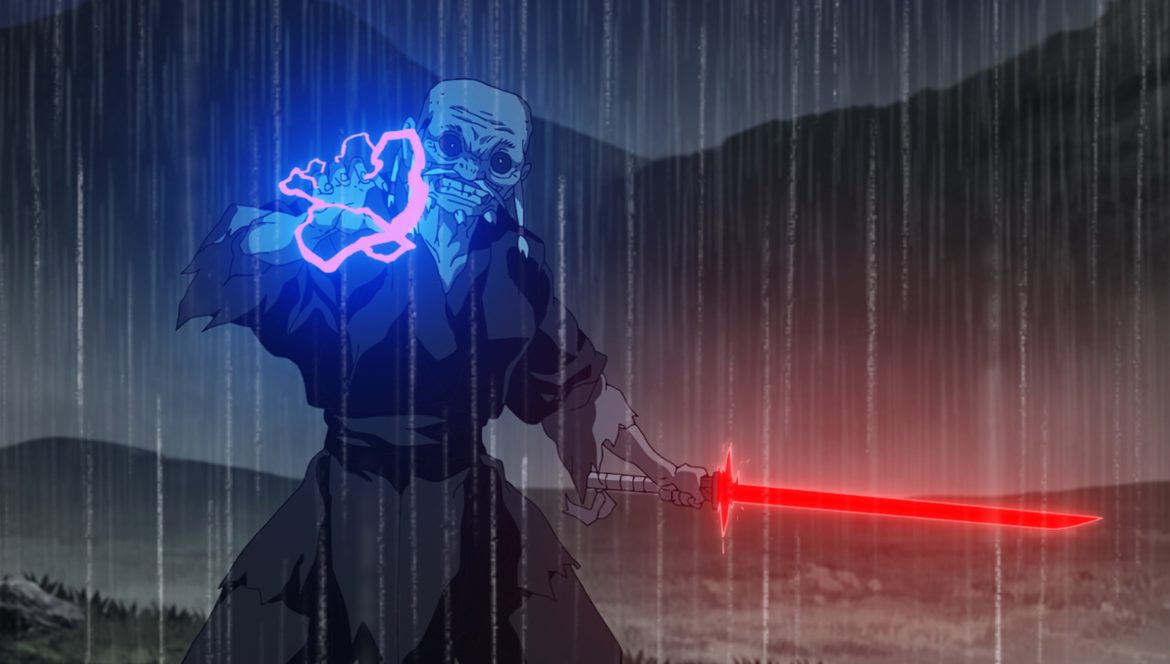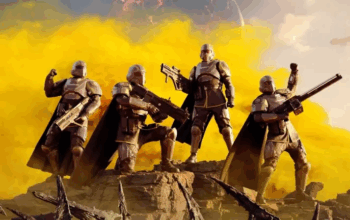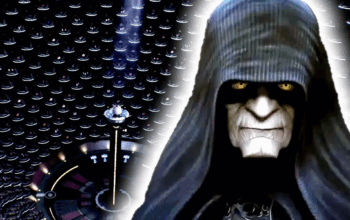There were many elements that inspired George Lucas in Star Wars, from westerns to gangster flicks to Flash Gordon. Of course, what truly inspired Lucas was Japanese cinema, most notably citing Hidden Fortress and Yojimbo as influences. Jedi, essentially being Samurai with lasers, his universe was built for anime.
Independent animators have delved into this possibility before but never had any major backing from any studio, until now.
What amazes me about this series is that is does a great job treading the line from canon and non canon, as many of their stories cleverly tie into the overall history of the galaxy without altering the core story or so much as mentioning the main cast – a chance for the artists to play in the Star Wars universe without worry for lore-smashing or breaking continuity.
I went into these episodes out of order ranging from shortest and most childish to longest and more adult.
9: T0-B1
To sum it up, this was Star Wars’ Pinocchio – a droid that dreams of being a real boy Jedi. This certainly begs the question: “can droids wield the force?”. The art style and childish-wonder tone is a rather tasteful homage to Astro Boy, one of Japan’s oldest cartoons, and clearly aims for style over substance.
Ultimately, we appreciate this as an artpiece, but without much appeal to what draws us to either Star Wars or anime.
But it was cool to see a Skyhopper prominently featured.
8: Tatooine Rhapsody
To have a Star Wars in-universe episode focus on a rock band is a bizarre choice, however if the cantina band can be park of the official sound track then so can they.
I do wonder, however, if that teenage Hutt was Jabba’s son Rotta from the Clone Wars TV series was going through a phase. I have to admit the actual musical number at the end I would have enjoyed more if it was in a Star Wars language like Huttese.
7: The Elder
Compared to the other episodes, this story is pretty straightforward – 2 Jedi encounter a mad swordsman on a planet.
The most interesting part however is the titular elder. This little-old-man-2-blades sounds almost like an evil Yoda.
But what really caught my attention was when this demonic warrior was defeated as we see it’s body decay rapidly into the dirt. Almost like some Sith had their own dark side way of dissappearing into tho living force like the Jedi. What was telling was the Idea that some of the Sith broken off with the order after being destroyed by the Jedi 1000 years before the films. Perhaps this is a timeline set after the Sith were wiped out and the Bane line was still being established. It left a lot of questions, but the Jedi characters were pretty weak.
6: Akakiri
Another possible Old Republic-era story, this episode follows a Jedi trying to save someone he loves from a vision.
This was among the shortest at 13 minutes and puzzlingly the was the last one in the season’s setlist. The story lacked much substance – just the “join the dark side and me” trope we’ve seen so many times in this.
Except unlike other Star Wars tales, the lead actually does switch and actually uses his new dark powers to save his lover. This could have been a powerful moment but because this episode is so short and the characters are so standard there’s nothing to connect with. As a final episode in this list it’s a weak one to end with.
5: The Twins
This was the One Punch Man of the series – completely over the top.
To sum it up, this was something unexpectedly on the nose. A literal twin star destroyer described as a Gemini class, with a hyper canon that’s powered by Kyber Crystals that’s channeled through the dark twins’ dark armor. It already reads like a Saitama-worthy plot.
Then the twins inevitably fight in space without suits and the sister metamorphosizes into a 6-lightsaber wiping cyborg. All of this culminating with a hyperspace ramming that unlike episode 8 felt earned given the style.
Completely ridiculous. Absolutely stupid. I love it.
4: Village Bride
This episode focuses on a former Jedi Padawan who’s master was killed (implied by Sidious). This has a more Asian environmental aesthetic to this planet, ala Princess Mononoke or any other spiritual Miyazaki project.
What is also fascinating is that it appears that the planets inhabitants appear to relate to the force spiritually in a manor unknown to the Jedi. One this planet it was referred to as Magana and it manifested in some form of crystal embedded in a mountain to whom the newlywed couple pays homage.
Something I like about these episodes is that they evolve the idea of the force. The planet itself may have some form of sentience as its natural features replay memories to whomever touches a sacred crystal.
I also like the idea of pirates operating reprogrammed battle droids salvaged in the aftermath of the clone wars. What I didn’t like was hearing the same goofy Mathew Wood voice that’s in my opinion is to comedic for an episode of this caliber.
3: The Duel
This episode is straight out of an Akira Kurisowa film, down to it’s opening.
In this apparent post imperial timeline It’s cool to see brigands operating Storm trooper hardware and taking orders from an apparent Sith. The part that really took me by surprise however was the Supposed Jedi turns out to be a rough Sith, or perhaps an inquisitor considering the timing.
Another element I enjoy was the lightsaber designs. When I saw umbrella lightsaber in the trailer I thought it was a little bit much, but turns out to be an extended attachment meant to focus one blade into several. My only wish is that she has more of a lightsaber naginata rather then a standard blade. I also love the wandering Sith Ronin’s saber katana sheath which turns out to be a 2nd long handled lightsaber in disguise.
Ronin seems to be an antihero version of general grievous where he collects red Kyber Crystals, however, to show he’s not heartless, he does give one crystal to the local villages saying that they are worth a high price. A fitting end to this first episode.
3: Lop & Ocho
What If I were to tell you that may favorite episode the serious gritty origin of Lola Bunny.
Joke aside this episode have the most compelling drama in this series as it focuses on a family being torn apart between loyalty to the Empire or loyalty to their planet. The main character is Lob a Rabbit like alien who escaped imperial slavery as a child who’s adopted by a human family on the planet Tao. Several years later her family becomes torn between her sister Ocho who believes in the empires cause of civilization and “progress” and her adopted father who leads a planetary union against the Empires exploitation Tao’s resources.
There are so many layers being taped into this story, generational loyalty’s, colonialism, even casual racism as the father was reluctant to adopt an alien into his family. Ironically he would entrust with heirloom a lightsaber that was passed from generation as his family was descended from a Jedi who once lived among his clan. One could wonder if perhaps because Lop was force sensitive that he decide to adopt her.
It’s also interesting that we get an Idea how the empire expanded without much resistance as some planets appealed to the empire for industrial assistance to which they so happily obliged. Similar to how some historical empires such as the Romans or even the United States’ manifest destiny.
1: The Ninth Jedi
I’ve seen this episode last and I’m glad I have. This was the longest at 22 min and carries the most in terms it’s Lore.
It isn’t clear what time it is set, weather it’s a completely separate timeline or the far future, but what we do know is that the Jedi and Sith have once again gone extinct aside from scattered survivors. Being summoned by a mysterious being called the Margrave these exiles have gathered to be given long disappeared lightsabers from a saber smith that rediscovered the art.
What was cool was seeing the process making a lightsaber starting with orbital harpoons launched from the plant to retrieve these asteroids. The large crystals are cut and shaped into smaller pieces that are small enough to fit into a handle. The coolest part is that in this episode the crystals reflect the wielder’s connection to the force meaning they change color to whoever touches it. What caught my attention the most was the Smiths daughter Kara’s saber is clear indicating her connection to the force hasn’t been established.
The biggest twist is that it’s a trap within an obvious trap. Most of the supposed exiled Jedi that have gathered were actually Sith loyalists meant to trap the saber smith and Jedi stragglers. The seemingly evil Margrave who is actually a Jedi master in disguise has anticipated this move and the lightsabers were meant to reveal who’s friend from foe.
In a middle finger to The Last Jedi, this is subversion of expectations done correctly.



